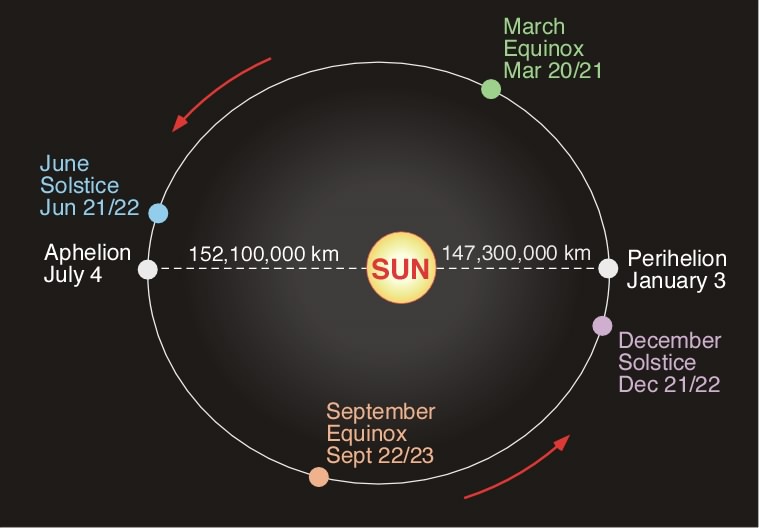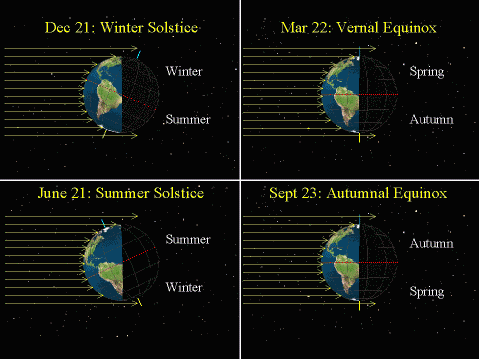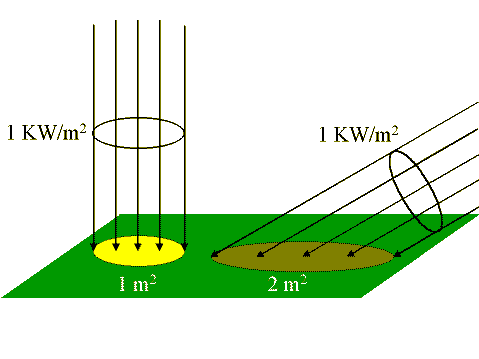...and a time to every scientific topic under heaven. A time to blog, a time to refrain from blogging due to the constraints of a non-academic job, and a time to get one's schedule under control and resume blogging. Hello, and welcome back to Delusions of Grandeur! It's been a heck of a hiatus, but we're back to our regularly scheduled programming of a little of everything. There are many fine places I wish to take you, dear readers, from soil orders to paleoclimate, but let’s start with something that has been on my mind lately. Seasons.
For those of you reading from the tropics, I’d like to apologize in advance for the mid and polar latitude-centric nature of this post. Rest assured, I will devote a future post to an equatorial topic. For those of you reading from the mid-latitudes, in particular, have you ever noticed just how much of our culture(s) is informed by the reality of four distinct seasons? Think beyond the obvious. In nineteenth century Europe, the annual extravagance of the spring blossoms and autumn harvest had a clear impact on the Romantic movement, while the annual bloom of the cherry trees has long been important in Japanese culture. Moving away from flora, the sharp contrast between the summer and winter months in the mid-latitudes has inspired tales like how the hero Glooskap, in one of his many acts of magnanimity towards the Abenaki people, brought fixed seasons to the land. I could toss out some more examples, but the point is clear - away from the equator, seasonality shapes life. But what, exactly, shapes seasonality?
 | ||
| Don't worry if you missed it this year, you've got next season. I guarantee. |
First, let’s define “season”. Technically, a season is any period of the year, as defined by weather or work. So, you can have a growing season, a dry season, a baseball season; all usages are technically correct. In fact, the word originally applied exclusively to the time when fields were sown. For the purposes of today’s investigation, we’ll be defining season as any one of the four approximately equal periods into which the solar year is divided, based on rotation around the Sun, and the tilt of Earth’s axis. At a future point, we’ll take a look at the phenomena of wet and dry seasons - those are governed by weather patterns, and as the names indicate, typically have to do with precipitation.
We’ll start with revolution around the Sun.

As you all know, the Earth revolves around the Sun, with each revolution lasting 365 ¼ days. The orbit of the Earth is not quite even. Perihelion refers to the point in each orbital cycle when Earth is closest to the Sun, aphelion to the point when Earth is furthest. This plays a role in seasonality, but a very minor one. We need to look at axial tilt to get the full story.
So, axial tilt! What is it? In the words of many an English teacher, show, don’t tell.

The Earth spins as it rotates, with each spin lasting 24 hours. The Earth, however, is not quite spinning on a straight axis - the imaginary line one could trace from the North Pole through to the South Pole is not perfectly perpendicular to the ecliptic, the theoretical plane on which the Earth orbits the Sun; rather, the axis is tilted at 23.5 degrees relative to that the ecliptic.

The Earth spins as it rotates, with each spin lasting 24 hours. The Earth, however, is not quite spinning on a straight axis - the imaginary line one could trace from the North Pole through to the South Pole is not perfectly perpendicular to the ecliptic, the theoretical plane on which the Earth orbits the Sun; rather, the axis is tilted at 23.5 degrees relative to that the ecliptic.
Cool. What does this mean? Well, think about it. If the Earth’s axis was perpendicular to the ecliptic at all times, the Equator would always be closest to the Sun, the poles would always be furthest, and the mid-latitudes would always be somewhere in-between. Latitudes equally distant in opposite directions from the Equator (say, latitudes 45 N and 45 S, or the very approximate locations of Montreal, CA and Wellington, NZ) would consistently experience the same day length at the same time. As anyone from the Northern Hemisphere who has taken a winter vacation to the Southern Hemisphere (and vice versa) can tell you, this is manifestly not the case.
Enter tilt. 23.5 degrees is just enough to ensure that, for portions of Earth’s revolution around the Sun, one hemisphere is closer to the Sun than the other. When one hemisphere is closer to the Sun, the days in that hemisphere are longer than the nights, and the amount of sunlight hitting the ground (and subsequently warming the air) is greater than at all other times. This is a consequence of Earth being round. Take a look at this image.
 |
| The arrows represent incoming sunlight. |
See how the sunlight hits Earth? Imagine a flashlight shining on a ball. At the “equator” of the ball, the light falls in one fairly tight beam. At the “poles” of the ball, the light is more diffuse (try it with some household objects, if you don’t believe me). The same factor is at play with the Earth. When a hemisphere is tilted towards the Sun, the incoming solar radiation in latitudes further from the Equator behaves a little more like solar radiation at the Equator. Got it?
 |
| Incoming radiation on the left is what you would get at the Equator, incoming radiation on the right is what you would get closer to the poles. |
And there, in a nutshell, is the reason for the season. In the summer of either hemisphere, incoming solar radiation is greater, on account of tilt. For the same reason, winter is the result of tilt pointing the hemisphere away from the Sun. The effects are more pronounced at the higher latitudes, where the summers are characterized by constant sunlight, and the winters by a complete absence of sunlight (think about what parts of the globe are most tilted towards/away from the Sun, relatively). The orbit of the Earth around the Sun comes (slightly) into play here; perihelion occurs during the Southern Hemisphere summer, which means that this hemisphere receives more intense incoming solar radiation during its summer. As far as average temperatures go, however, there is very little difference between Southern and Northern summers. A greater proportion of the Southern Hemisphere is water, which is less sensitive to being warmed via solar radiation, and that evens out the variation.
Ok, we’ve got summer and winter explained; what about fall and spring? And what’s up with equinoxes and solstices?
We generally don’t celebrate solstices and equinoxes the way we once did, but there is a reason they are a feature of our calendars. The solstice, both summer and winter, refers to an extreme in the progression of Earth through the tilt cycle. Summer solstice, in a given hemisphere, is the point at which that hemisphere is most tilted towards the sun, winter solstice is the point at which that hemisphere is most tilted from the Sun. We’ve known about this since long before we had any ideas about the tilt cycle, because the solstices also correlated to day length. The summer solstice is the longest day of the year, the winter solstice is the shortest day of the year (note that “day” refers to length of the sun being above the horizon; the Earth always takes 24 hours to complete one revolution).
 |
| Left-most sphere shows Earth at the Northern Hemisphere summer solstice, Jun 21 or 22 |
Hang on. Summer is marked as beginning at the summer solstice, winter as beginning at the winter solstice. The winter solstice is the shortest day of the year. Logically, that is the point at which the days start getting longer. But winter is cold. How can it be that the part of the year when day length is increasing is also the part of the year with, on average, the coldest temperatures?
Funny you should ask. One “Herb” asked the same question of a US Department of Energy “Ask a Scientist”, and received the following pithy reply from one Dr. Cook.
“It takes the Earth a long time to cool off. Heat has to be released from a significant storage of energy in the ground, trees, buildings, etc. While the cooling is taking place, a lot of energy is still being released into the atmosphere, slowing the cooling. So, the coldest temperatures come later, after this cooling has occurred (in January or early February).
The reverse situation occurs in the Summer. June 21 is not the hottest day of the year in the Northern Hemisphere, as it takes the a long time for the ground, trees, buildings, etc. to warm up; the warmer they become as the Summer progresses, the more heat is released into the atmosphere, resulting in the hottest days being later (July and August). “
 |
| Probably not taking place on June 21st. |
Dr. Cook even answered the related question regarding the summer solstice. Thanks, Dr. Cook! Oh, and the technical term for this phenomenon is “thermal lag”. The period when there is less incoming sunlight, and the Earth is still cooling off covers the fall, and the period when there is more incoming sunlight, but the now-cooled Earth is still heating up covers the spring.
The equinoxes (vernal in the spring, autumnal in the fall) refer to the two points in the solar year when the Earth is actually parallel to the Sun. On these two days, day length is equal throughout the Earth. Fittingly, the equinoxes fall right between the solstices, as the solstices represent the two extremes in day length.
That’s seasonality, the short version. Now that we’ve covered this, we can devote later posts to interesting quirks of seasonality, like the important, but difficult to spell Milankovitch cycles. Or seasons on other planets; yes, other planets have seasons, and for more or less the same reasons. As for now, whatever hemisphere you’re in, and whatever seasonality you experience, get out there and enjoy it!